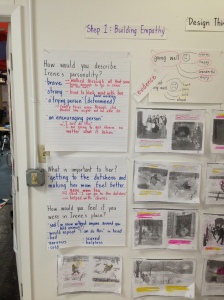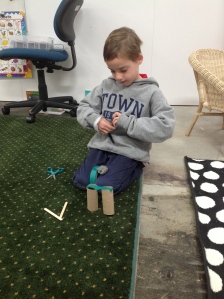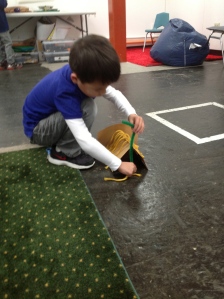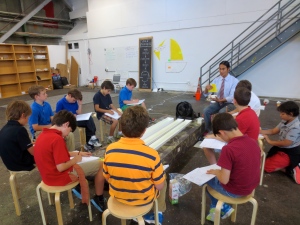Kindergarten teacher Lou Frelinghuysen was grappling with ways to teach her students story elements, including character development and identifying problems and solutions, as well as finding text evidence to support their inferences. Curious about design thinking, she decided to use it to teach her students creative problem solving while building reading comprehension skills.

A designer herself, she played around with a few different ideas in planning the unit. First, she chose a book with a compelling protagonist and clear problem. She chose William Steig’s Brave Irene, in which a plucky little girl doggedly brings a gown to a palace for a ball amidst a wicked snowstorm. Listen to Brave Irene (read by Al Gore) here on Story Online.
Then, she planned the lessons, breaking them down into each stage of the design thinking process. Initially, she ambitiously tried to combine crafting needs statements and brainstorming in one lesson, but realized she needed more time to model the needs statement. I share this to show that she too was embracing a prototyping mindset trying out a new instructional method, likely building empathy with her students!

Next, to showcase her students’ work, she devoted a nook in her room to the design wall. Here, she hung student work from each stage of the process to see their progress through the process. It also highlighted the divergent thinking at each step of the way, celebrating their creative thinking.
Here is an overview of how she taught the unit:
1. Empathizing: In her introduction, she linked empathy with work the students have done in the classroom in conjunction with a global PBL, in which the boys have practiced interviewing, perspective taking, and collaboration (for more info, check out the classroom website here). Lou shared, “As I read I began to think aloud about what type of a person she was (and what evidence tells me that), what is important to her, and how I might feel in her place. As I read, I had boys join in and talk about how they might feel if they were in her situation. Some boys shared that they are also happiest when home in a warm house with their mothers. Others had also had experience with twisted ankles and knowing you need to get up and keep moving even though you are hurt. We played a mini-game of charades where I had boys make whatever expression Irene was making in the illustration and talk about what she might be feeling in that moment and why. When we came to the description of Irene shivering and chattering, boys pointed out that those words told us that she was cold. When the box flew away from Irene, I asked how boys thought she might be feeling and Remy said he felt like she might be worried that her mother would be mad. Lo and behold, a page later we read, ‘Would her mother understand, she…'”
To anchor the boys’ inferences in textual evidence, she partnered them up and assigned each partnership one or two pages to review. As Lou described, “The boys were tasked with highlighting (in pink) evidence in the words or illustrations that showed things were going well for Irene, such as the words ‘happy’ or ‘bright light’, and highlighting (in yellow) evidence that demonstrated things were not going well for her, such as the words ‘pain’ and ‘cried.'”
2. Defining needs: To define needs, she adapted a needs statement page she’d used in a workshop to work for her Kindergarteners. Much like a Madlibs, her needs statement student work pages said, “Irene is ________________. She needs _________________ so she can _________________.” Within that structure, boys came up with different but appropriate adjectives to describe Irene and her needs. Some boys targeted her reaction to her challenge, describing her as “sad” or “frustrated.” Others identified her tenacious character, describing her as “brave.” Variation also occurred in describing her needs, where ideas included “someone to help”, “animal friends”, “someone to pull her.”


3. Brainstorming: The boys then brainstormed solutions to the individual problems they identified. Lou provided another developmentally appropriate graphic organizer, with four boxes to sketch ideas. She also gave prompts to help them connect their needs statement to their possible solutions
4. Prototyping: Using low resolution materials, Lou had the boys then build prototypes of their solutions for Irene. The boys cleverly used materials to express ideas. As Lou elaborated, “Blake made a dagger out of tape and cardboard and shared, ‘This is a dagger to help Irene to cut down wood to make a fire to keep her warm, and if there any any wild animals so she can kill the wild animals.’ Aidan made two sleds out of toilet paper rolls, tape, and popsicle sticks. He explained, ‘These are sleds so when she broke her ankle she doesn’t need to walk. She can just slide on sleds so she doesn’t need to walk and her foot will get better.’ D made a dinosaur out of clay and paper and said, ‘This is a dinosaur so that she could ride on it and it could carry her down.’ Theo constructed a house out of paper and string. He told us, ‘This is a house so that she can stay warm.’ Nathaniel made a sled out of clay that had a jet attached. Benjy made a car from a cardboard container to get Irene to the palace ‘in one second.’ Everett made a sled out of clay, tape, and pipe cleaners so that, ‘she can get to the duchess.’ Shloak constructed ‘a bus that goes underwater’ out of a toilet paper roll and tape and Remy fashioned a first aid kit our of paper, packing materials, cotton balls, string, and popsicle sticks. He explained, ‘It can help her if she was bleeding, this [the popsicle stick] could get a little blood off, and this is the bandaids [cotton balls]…’ Caden also made a dagger out of cardboard, tape, and a yogurt container. He said, ‘This is a dagger, just like Blake, to kill wild animals so she doesn’t feel scared out in the big wild areas, and she can just cut down trees, but I don’t think a dagger can really cut down a tree. She would maybe have to work all year.'”
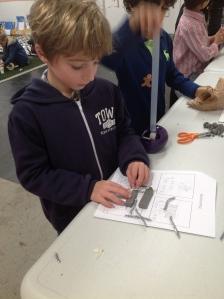
5. Reflection: Since the boys wouldn’t be able to test their prototypes with a fictional story character, Lou deftly adapted this phase of the process to a reflection. Here, she scaffolded feedback in two steps: I notice… and I wonder… After sharing their observations and questions, she had the group share their favorite and most difficult steps. They also circled back to their prototypes, asking if they would address Irene’s needs. Finally, she reinforced the collaborative nature of small group learning environments by asking them to think about how their classmates helped them.
Lou found the students were open to sharing their experiences, “Remy shared, ‘I noticed that Caden’s is really beautiful.’ Benjy noted that Theo ‘worked really hard’ on his house. Caden shared, ‘Blake was running out of time so I helped him very fast. So I just wanted to say Blake, nice working together.'”
Lou’s reflection:
I loved going through the design thinking process with my students. It was a challenge to try something different from what we do in the classroom on a daily basis, and the boys were engaged throughout each step. I felt that they boys were able to empathize with Irene and they became adept at explaining what clues the text supported their thinking. While I’d tried to scaffold the evidence gathering as best as I could, I think that the text was complicated and in the future, might either use a simpler book or do that step as a whole class. I’m afraid that I didn’t model the needs statement as well as I should have. I modeled it with a more specific example and consequently some boys’ needs statements contained specific solutions rather than broader concepts. I realized this when a handful of boys suggested that Irene needed “a man.” Eeek. (Not exactly the magical kindergarten thinking I’d expected.) Trying to reframe their thinking, I quickly asked those boys, “What does Irene need a man for?” and they replied “to help her stay warm,” “to give her comfort”, and “to help her get to the palace.” I applauded their thinking and asked whether they felt the need was the man himself or rather to stay warm, feel safe, or help getting to the palace. From that point they successfully moved on to brainstorming. I was very impressed with their prototyping skills and the thought they put into their work. I worried that it would be hard for the boys to stop work after 8 minutes and so explained that rapid prototyping was fast, and that their products needn’t and shouldn’t be finished or perfect. I would have loved to have one more day to reflect and perhaps allow boys to give each other feedback. It would have been interesting to see both their suggestions as well as their reactions to their classmates’ questions and suggestions.



